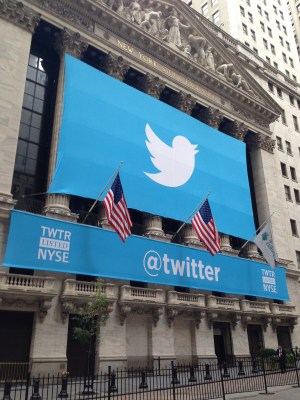Twitter’s stock is slipping today, shedding around 4.5 percent of its value in regular trading. That works out to around $1.3 billion in market capitalization, calculating with a fully diluted share count of 705,098,594.
Its decline coincides with a very public record for the tech-heavy NASDAQ exchange, which traded over the 4,000 mark earlier today. As the USA Today reported this morning: “The Nasdaq composite topped 4000 briefly for the first time since September 2000 in early trading Monday, [after] it crashed 78% to 1114 in the 2000-02 bear market.”
But Twitter trades on the NYSE, not the NASDAQ, which remains something of the market of record for technology if we can bend the cliche to our will. So to see NASDAQ’s rise coincide with Twitter’s fall today means that the social company is losing altitude at a slight angle to the market. If Twitter fell on a day in which the majority of technology stocks also lost a similar cut of their value, it wouldn’t mean a thing. The NYSE is also up today, over the record 16,000 mark, sitting around 16,091, up roughly 0.16 percent.
According to Google Finance, broader technology stocks are off around 0.15 percent, so the climate isn’t perfect this Monday for Twitter. Still, the size of its decline and its fall through the $40 price floor is worth noting.
With a current share price of roughly $39, Twitter is well down from its first-day IPO pop of $45.10, but is up from the level it priced its shares: $26. In the vein, keep in mind that Twitter initially indicated that it would price its own equity at as low as $17 per share.
That in mind, the company is miles and miles away from becoming a failed IPO in any sense whatsoever, unless you were the person who bought in at $45.10 on its first day of trading, naturally. As I wrote recently:
The markets and larger technology industry will closely watch Twitter in its first few quarters, given that the degree of its success – or weakness – as a public company will set the temperature for other companies’ IPO paths.
The company’s first months’ trading could set the stage in my estimation for its first year or two of public life, as was the case with Facebook. The company could continue to ease until its first quarterly earnings report, at which point the first hurdle will present itself.
Coverage out this morning from the New York Times is typically gaunt and accurate in its own way:
Once again, new “metrics” are being applied to justify stratospheric valuations. Twitter is losing money. A price-to-earnings ratio? There is no E in the P/E. But its stock is trading at 20-odd times the company’s annual sales. Good enough.
Only, we all know that it is not. Talk to folks about Twitter’s valuation and the metric of choice for the period after its first public year is its operating margin. People expect it to match Facebook’s. The direct implication there is that people are expecting Twitter to have the E in the P/E, and not too far out.
What that looks like in the short term is that Twitter aggressively expands its revenue base using its new capital, and then perhaps slows its cost growth to levels below the delta of its top line increase. Then, continue that process through break-even and into the black.
So, though Twitter has slipped from its massive day-one IPO jump, none of the fundamental strengths and weaknesses of the firm have changed. Barring something large, it’s a coast all the way until D-Day for the firm: earnings.

